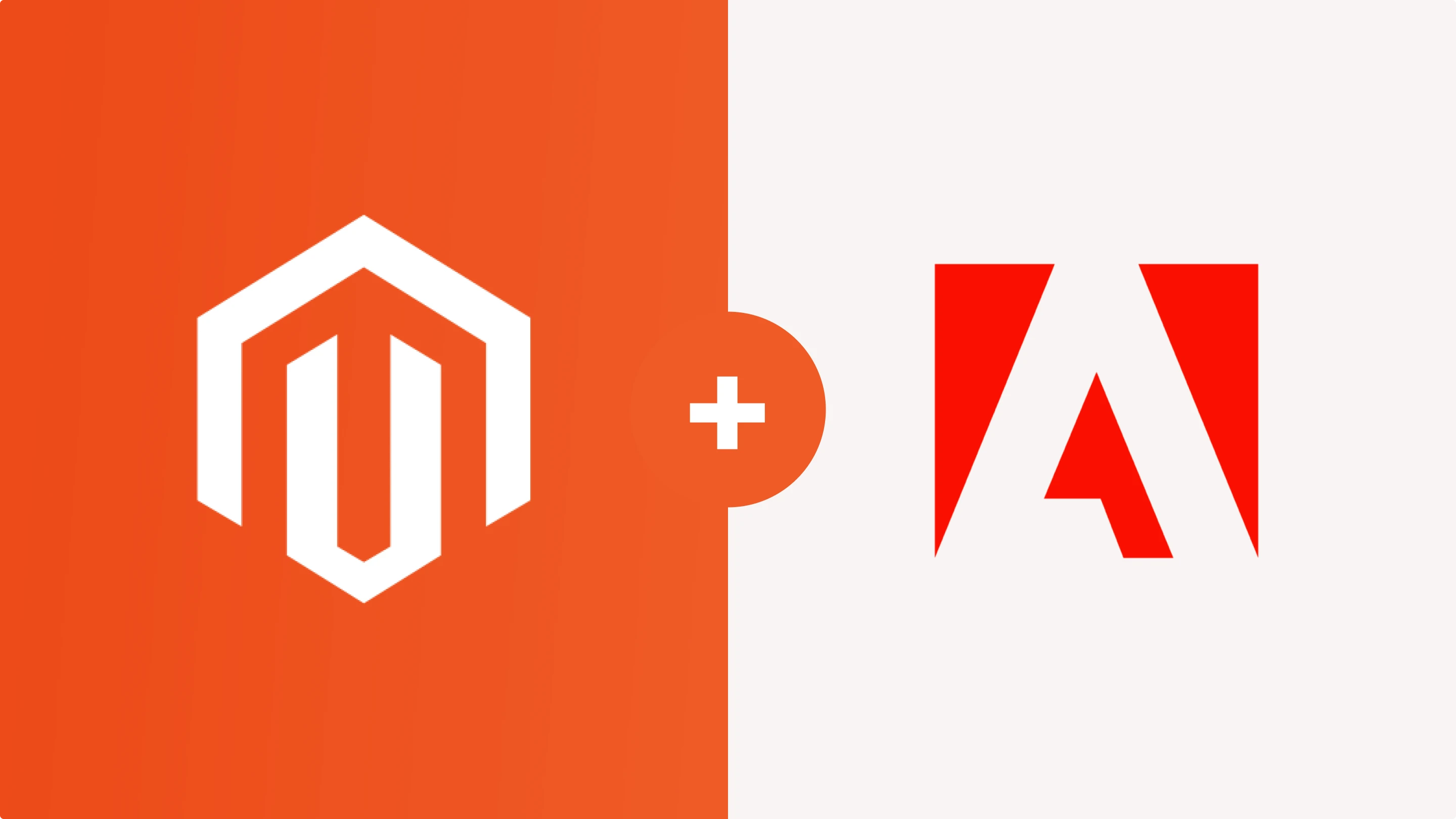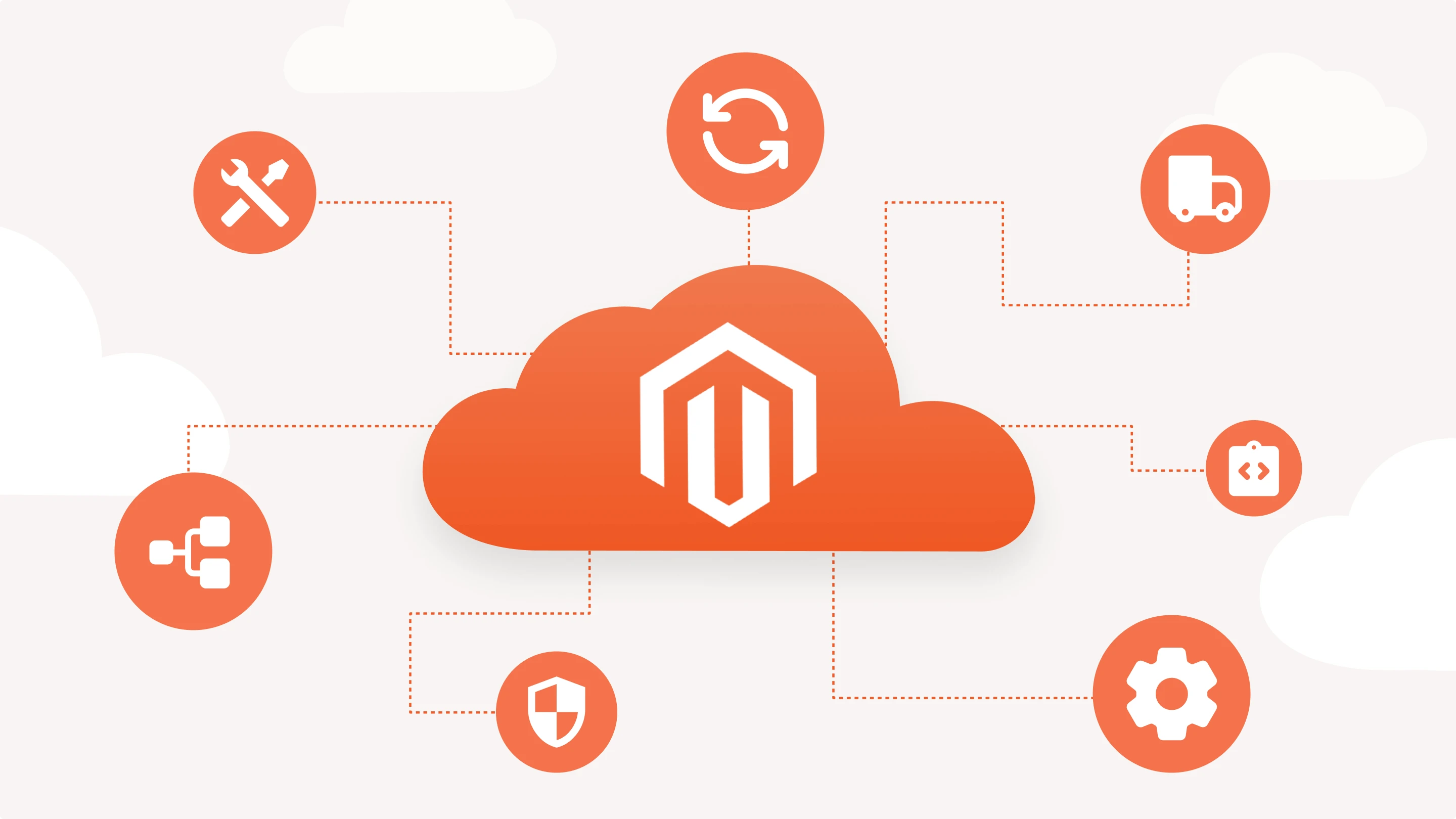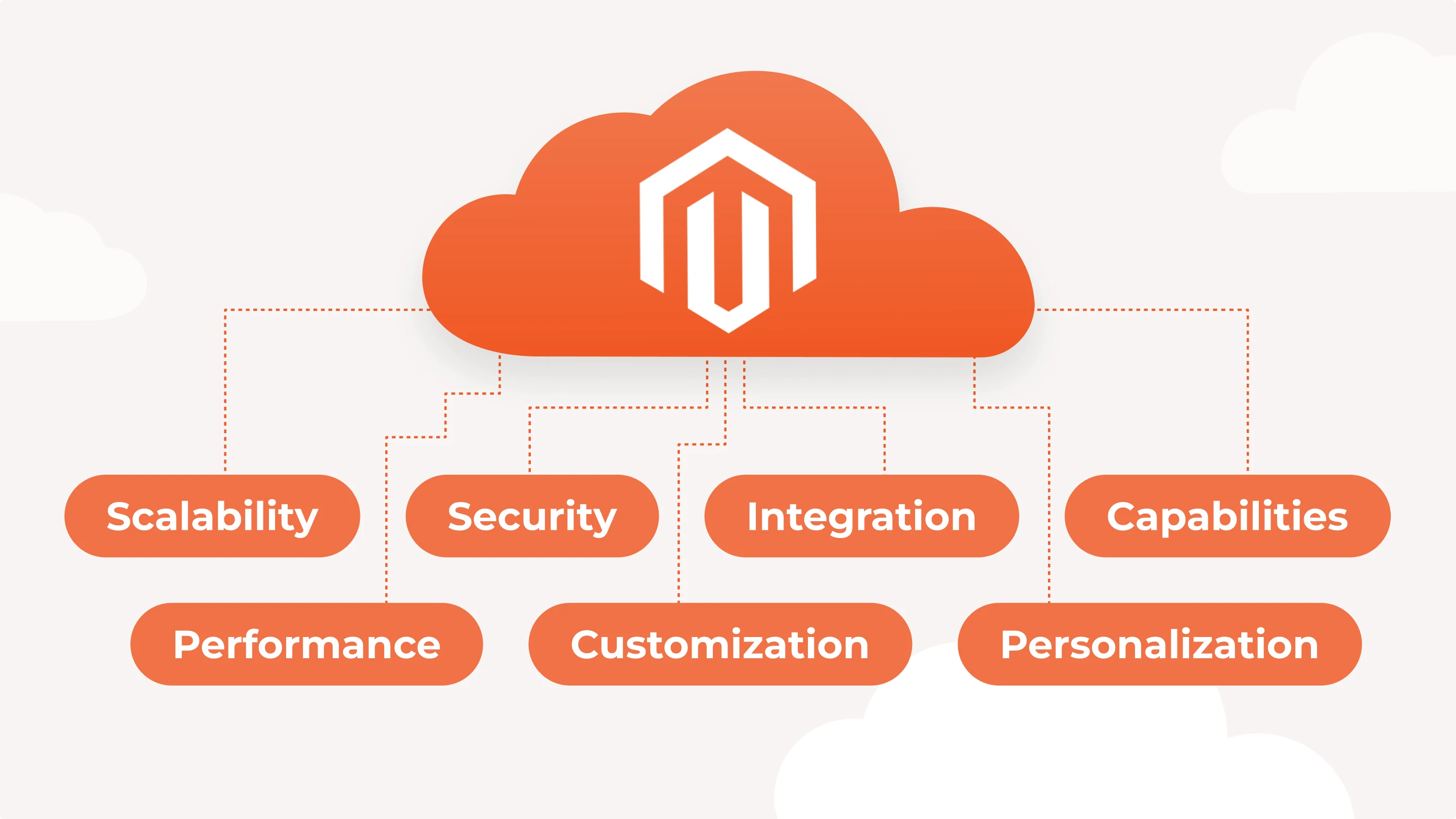Magento 2 Commerce Cloud: Enterprise Cloud Edition Pricing, Plans
Nowadays enterprises need a powerful e-commerce store base that can rapidly expand and adjust to inconstant circumstances. Magento 2 Commerce Cloud is focusing specifically on these issues. It hosts an extensive selection of features adapted for the expanding commercial needs. Let's explore the traits of Magento Commerce Cloud, examine its subscription tiers and packages, and comprehend why it holds a leading position in the e-commerce market.
Understanding the Magento Commerce Cloud
Since Adobe purchased the platform, the open-source Magento version has grown into a premium Adobe Commerce Cloud solution. Combining Magento’s flexibility and Adobe's vast resources, Magento Commerce Cloud possesses an adjustable and easy-to-scale infrastructure, stimulating enterprises to expand and evolve rapidly. Cloud technology helps to achieve exceptional stability, efficiency, and effortless scalability, effectively managing traffic spikes and accommodating product catalogs' growth.
A distinguishing factor of Magento Commerce Cloud is its completely managed nature. Unlike traditional platforms where store owners have to deal with hosting, maintenance, and conduct safety measures, Magento Commerce Cloud handles these operations on clients’ behalf. This allows e-commerce brands to focus on business growth and strategic initiatives without diving into the tech details.
Magento Commerce Cloud integration with Adobe Analytics and Marketing Cloud utilizes significant insights regarding user behavior, promotions efficacy, and broad commercial activities. Hence, webstores can personalize buyers’ journeys, launch promotional campaigns, and shorten the time to market for their goods.

Adobe Commerce Cloud Components
Magento Commerce Cloud consists of several critical attributes. Let's assess each element to comprehend its role under the Adobe Commerce Cloud umbrella:
Cloud Infrastructure
Central to Adobe Commerce Cloud is a sturdy cloud infrastructure that leverages reliable cloud providers, such as Amazon Web Services (AWS) or Microsoft Azure. This infrastructure establishes the groundwork for hosting, guaranteeing swift loading speeds and smooth expansion.
Security Features
Adobe Commerce Cloud prioritizes safety by incorporating solid security protocols. They include encryption, firewalls, automatic updates, and alignment with industry standards such as PCI DSS (Payment Card Industry Data Security Standard). Therefore companies make sure that their data is safeguarded against external threats.
Automated Deployments
Optimizing the setup process is key for agility and efficiency. Magento Commerce Cloud has automated deployment capabilities, so brands can introduce updates and enhancements efficiently and mitigate disruptions.
Integration with Adobe Tools
The incorporation of Adobe's Experience Cloud capabilities is a hallmark of Magento Commerce Cloud. This consolidation leverages promo automation with Marketing Cloud, data insights with Adobe Analytics and Real-Time Customer Data Platform, and personalization of the client’s experience with Adobe Target and Adobe Journey Optimizer to improve user engagement, manage campaigns, and stimulate revenue growth.

Content Management System (CMS)
With an effective CMS, merchants can establish compelling and tailored shopping experiences for their clients. Adobe Commerce Cloud smoothly incorporates Adobe Experience Manager (AEM), supplying a potent CMS for effortlessly crafting, organizing, and distributing content across numerous digital channels.
Content Delivery Network (CDN)
Magento Commerce Cloud incorporates a Content Delivery Network (CDN) to skyrocket the web performance and distribute content efficiently to users worldwide. A CDN stores static content like images and JavaScript files on servers spread across various geographic locations, diminishing latency and enhancing page loading speed for users.
Integration Framework,
Magento Commerce Cloud utilizes a flexible integration framework for external apps, services, and systems. Merchants can grow their store’s capabilities by incorporating ERP (Enterprise Resource Planning), CRM (Customer Relationship Management), additional payment methods, marketing services, APIs (Application Programming Interface), and add-ons with minimum development efforts.
Developer Tools
Adobe Developer App Builder empowers you to broaden the native Magento’s capabilities to support customizations, plugins, and integrations. A robust API allows sellers to expand existing features, development environments, and deployment tools to design and implement new build-ons.
Monitoring and Analytics
Magento Commerce Cloud equips clients with valuable reports on the performance of their websites. One dashboard allows tracking handpicked KPIs and visualizing website traffic, conversion rates, and revenue metrics. Moreover, Adobe equips its clients with tools to track customers’ journeys and analyze ad campaign results.
Order Management
Adobe Commerce Cloud supplies a vast toolset to personalize quotations, control stock, and fulfill orders through multiple channels, ensuring even client experience and operational efficiency. Store owners can pick different sourcing algorithms, prevent stockouts, and access updated warehouse data through multi-channel inventory tracking.
Customer Experience Management
Magento Commerce Cloud empowers brands to customize the user’s journey and product discovery. Shops can gain new clients by creating multi-channel marketing campaigns, creating loyalty programs, and tailored offers.
Key Features of Magento Commerce Cloud

- Scalability: Easy scaling to accommodate growing traffic and enlarging website catalogs.
- Customization: Adapting the storefront’s visual presentation to reflect the brand’s specific highlights and meet client engagement goals with customizable themes and extensions.
- Performance: Optimized content loading and smooth navigation for an uninterrupted shopping experience.
- Security: Safeguarding data from cyber-attacks through advanced security protocols, including automated updates and PCI compliance.
- Integration: Extended capabilities with external add-ons and software such as ERP and CRM systems.
- Personalization: Tailored buyers’ journeys with targeted ads and recommendations, adjustable pricing, and personalized content adapted to clients’ preferences.
- Multi-channel Capabilities: Consistent buyer’s journey on various channels and devices: desktop, mobile, and social media platforms.
How Much Does Magento Commerce Cloud Cost?
Adobe Commerce Cloud has two service tiers: Adobe Commerce Pro and Managed Services, each meeting distinct needs and company size.
The Adobe Commerce Pro is a solid all-inclusive package presenting fundamental features for different commercial models. Conversely, Managed Services is crafted for ventures seeking a fully managed solution incorporating exclusive functionality, top-tier performance, and steadfast security.
Unfortunately, these editions don’t provide straightforward fare plans. Numerous attributes affect the pricing of Magento Commerce Cloud, so the final estimation varies for every merchant. Key determinants include gross sales revenue, which correlates with pricing tiers, and site visitors per hour, which dictates resource allocation depending on traffic volume. Additionally, the number of integrations with external services and unique implementations can influence the final price.
\ When deciding between Adobe Commerce Pro and Managed Services, store owners need to take into account their business size, plan expansion trajectory, and evaluate transaction requirements. Therefore it is essential to consider not only setup and installation costs but also the future growth strategy for the store. By comprehensively assessing commercial expansion plans, organizations can leverage data-driven decisions that harmonize with their financial considerations.
Difference Between Magento 2 Open Source vs Adobe Commerce Cloud
Magento 2 Open Source and Adobe Commerce Cloud are two distinct editions of the Magento platform. Let's explore what sets them apart:
| Magento 2 Open Source | Adobe Commerce Cloud | |
| Hosting and Infrastructure | Within the free Magento version sellers are accountable for hosting their websites. Stores can cooperate with a hosting provider and maintain server infrastructure: handling updates, security measures, and performance enhancements. | The premium edition has an all-inclusive cloud hosting infrastructure, leveraging providers such as Amazon Web Services (AWS) or Microsoft Azure. Adobe Commerce handles server operations, updates, and performance, relieving merchants from the burden of infrastructure management. |
| Features and Functionality | Magento 2 Open Source provides fundamental online store capabilities such as creating items catalog, SEO, account management, admin dashboard, payment modules, and CMS integration. Nonetheless, it lacks certain advanced capabilities present in Magento Commerce Cloud. | Adobe Commerce Cloud contains all the goodies of Magento 2 Open Source, accompanied by advanced features like streamlined content management, deep research and reporting, site monitoring, tailored promo campaigns, B2B transactions support, and beyond. |
| Scalability and Performance | Although Magento 2 Open Source manages moderate levels of traffic and product catalogs. However, it might encounter scalability hurdles as items catalog and traffic expand. Ensuring speedy page loading takes extra enhancements and potentially entails additional budgeting. | Adobe Commerce Cloud is crafted with scalability as its main benefit, effortlessly accommodating rapid traffic expansion. Its cloud infrastructure exhibits exceptional reliability, even with high traffic loads. |
| Security and Compliance | With Magento 2 Open Source, the safety measures lay on store owners’ shoulders. Managers and admins have to adhere to security best practices, such as regular manual updates of security patches. | Adobe Commerce Cloud safeguards the store against cyberattacks and secures your data. The platform automates regular updates and aligns with security standards such as PCI DSS. |
| Prices | Magento 2 Open Source is completely free to install and use. Hence, becoming a worthwhile base for small and medium stores with limited budgeting or basic requirements. However, stakeholders should estimate financial resources for hosting, development, and maintenance. | Adobe Commerce Cloud has a subscription model, with price contingent upon enterprise size and model, integration requirements, and additional features.
Although it may entail bigger expenses in the beginning, store owners will receive an all-in-one managed service with top-tier functionality and premium support. |
FAQ about Magento in the Cloud
- What is the difference between Magento 2 Open Source and Adobe Commerce Cloud?
Magento 2 Open Source and Adobe Commerce Cloud differ primarily in their features, support, and pricing structures. Magento 2 Open Source is a free platform with basic core features essential for running an online shop. Business owners can establish a product catalog, fulfill orders, and access performance reports. It is a budget-friendly option for smaller ventures with limited expansion goals.
Adobe Commerce Cloud, known as Magento Commerce before, is a premium, completely-managed subscription service. It incorporates all the essentials of Magento 2 Open Source and incorporates top-tier solutions that help to accomplish the distinct goals of commercial ventures. It caters to fast-growing enterprises with specific design and integration requirements, providing premium support and an extended set of features. Therefore, store owners should expect to budget bigger upfront costs and subscription payments.
- Is Adobe Commerce Cloud good for small businesses?
Adobe Commerce Cloud was established to suit the increasing demands of large companies with intricate goals, so it can easily accommodate smaller online retailers providing a solid base for commercial operations enhanced with premium cloud products and support.
- Can I migrate my existing Magento 2 Open Source store to Adobe Commerce Cloud?
Certainly, you can transition your Magento 2 Open Source shop to Adobe Commerce Cloud. Adobe furnishes tools and assistance for transferring the store to cloud hosting, thereby minimizing disruptions to operations.
- What are the benefits of using Adobe Commerce Cloud over Magento 2 Open Source?
Adobe Commerce Cloud presents numerous advantages compared to Magento 2 Open Source, such as cloud hosting, premium features like B2B transactions, integration with other Adobe Cloud products and third-party services, rapid scalability, store and data security, premium support, and extra resources powered by Adobe.
- How does pricing for Adobe Commerce Cloud work?
Adobe Commerce Cloud tiers provide flexibility to individual commercial goals, operation scales, and integration requirements. Merchants considering migrating their store to Adobe Commerce Cloud should contact Adobe directly or consult with certified Magento partners for detailed information.
- What level of support is provided with Adobe Commerce Cloud?
Adobe Commerce Cloud delivers various tiers of assistance for every subscription plan. Support may contain valuable tech resources, service-level agreements (SLAs), and dedicated account management. Clients can choose the support plan that covers their potential issues.
Conclusion
Magento Commerce Cloud is a potent service for online ventures planning to accomplish their goals rapidly. Contrasted with Magento 2 Open Source, Adobe Commerce Cloud features a solid cloud solution with cutting-edge functionalities, expertly curated hosting solutions, and all-encompassing assistance. Merchants harness the power of performance enhancements, fortified security protocols, and integration opportunities to streamline operations and boost revenue. Whether it's expanding catalogs, enhancing security, integrating systems, or accessing advanced features, Adobe Commerce Cloud equips store owners with the tools to succeed and thrive in today's competitive e-commerce landscape.
